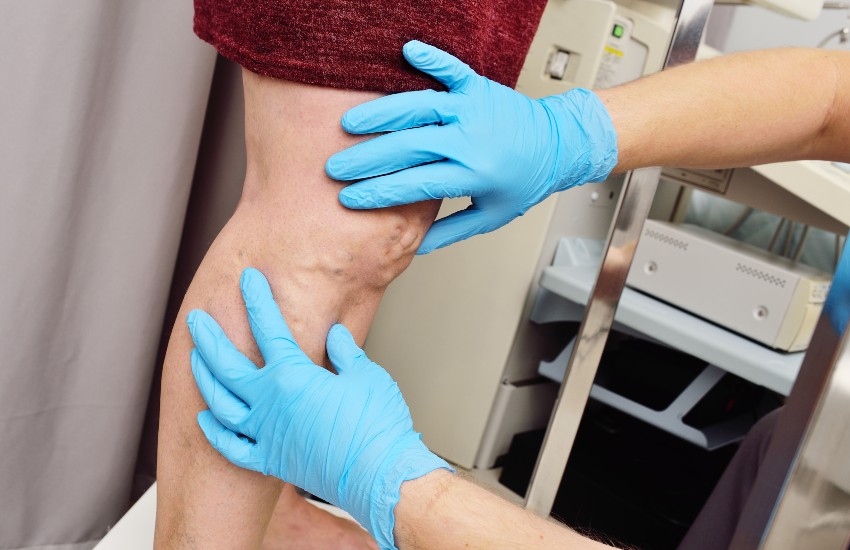How to Handle a Bleeding Varicose Vein
Varicose veins are a common yet often misunderstood condition affecting millions of people worldwide. These enlarged, twisted veins can cause discomfort and cosmetic concerns, but you have a more pressing medical issue if a varicose vein begins to bleed.
At Premier Vein & Vascular Center in Katy, TX, we offer comprehensive care for patients in the Houston area experiencing bleeding varicose veins. Learn the signs, symptoms, and treatment options for bleeding veins in the legs, along with preventive measures to help you maintain your vascular health.
Symptoms of Bleeding Varicose Veins
A bleeding vein isn’t always immediately noticeable. Sometimes, patients spot blood on their clothes or bedding without realizing the source. In other cases, the bleeding is more apparent, with blood visibly flowing from a vein.
Common symptoms of varicose veins bleeding include:
- Swelling, pain, and warmth around the affected vein
- Dark red or purple discoloration on the skin
- Blood-soaked clothing or bedding
- Increased pain or discomfort in the affected area
If you suspect you have a varicose vein bleed, seek medical attention promptly. Bleeding varicose veins are especially dangerous for older people with more delicate skin, patients on blood thinners, and pregnant women.

Causes of Bleeding Varicose Veins
Varicose veins develop when venous valves become weakened or damaged, causing blood to pool in the vein. The resulting pressure increase leads to varicose veins and, in some cases, causes the veins to bleed.
Factors that increase the risk of bleeding varicose veins include:
- Age
- Family history of varicose veins
- Obesity
- Prolonged standing or sitting
- Hormonal changes, such as pregnancy or menopause
Understanding the anatomy of varicose veins and the factors contributing to their development can help you identify the early signs of bleeding and take appropriate action.
Treatment for Bleeding Varicose Veins
If you experience bleeding veins in your legs, the first step is to administer immediate first aid:
- Elevate the affected leg to reduce blood flow and pressure on the vein.
- Apply direct pressure to the bleeding area with a clean cloth or gauze.
- Seek professional medical attention. You may need to have a suture placed to prevent re-bleeding, which may occur if you only attempt to apply pressure locally.
When you come to Premier Vein & Vascular Center with a varicose vein bleed, our medical team will stop the bleeding, evaluate your condition, and determine the most effective course of action. We offer several minimally invasive varicose vein treatments, including the following:
- Endovenous thermal ablation involves inserting a thin catheter into the affected vein, guided by ultrasound imaging. Once in place, the catheter delivers heat energy to the vein’s interior walls, causing it to collapse and seal shut. Over time, the body absorbs the treated vein, and blood flow redirects to healthier veins.
- Ambulatory phlebectomy involves making tiny incisions in the skin near the affected vein. A surgeon carefully removes the varicose vein through these openings using specialized medical instruments.
- Sclerotherapy involves injecting a chemical solution, known as a sclerosant, directly into the affected vein. The sclerosant irritates the vein’s inner lining, causing it to collapse and seal shut. The body naturally absorbs the treated vein and redirects blood flow elsewhere.
- Non-thermal vein ablation has emerged as an alternative to traditional thermal ablation methods. Instead of heat, these procedures employ adhesive substances or medicinal agents to close the compromised vein.
Prevention of Bleeding Varicose Veins
While preventing varicose veins from developing or bleeding isn’t always possible, you can take several steps to lower your risk:
- Maintain a healthy weight to reduce pressure on your veins.
- Exercise regularly to improve blood circulation.
- Avoid prolonged periods of standing or sitting, and change positions frequently.
- Wear compression stockings to help support your veins and prevent blood pooling.
- Elevate your legs when resting to promote proper blood flow.
In addition to these preventive measures, we recommend seeking regular medical checkups for varicose veins. Early detection and treatment help prevent complications, including bleeding varicose veins, and ensure well-managed vascular health.
Contact Premier Vein & Vascular Center
Bleeding varicose veins require prompt medical attention. The vein specialists at Premier Vein & Vascular Center provide comprehensive care and cutting-edge treatments for Houston-area patients with bleeding varicose veins. By understanding the causes, symptoms, and available treatments, you can take control of your vascular health and reduce the risk of bleeding varicose veins. If you’re concerned about varicose veins or have experienced veins bleeding, call 832-772-4899 to schedule a consultation at Premier Vein & Vascular Center. We’ll help you navigate your health concerns and provide the medical care you need for a healthier, more confident future.
